Themed collection Challenges in biological cryo electron microscopy

Correction: Image processing tools for the validation of CryoEM maps
Faraday Discuss., 2022,240, 228-228
https://doi.org/10.1039/D2FD90074B
List of participants
Faraday Discuss., 2022,240, 338-340
https://doi.org/10.1039/D2FD90076A
Poster list
Faraday Discuss., 2022,240, 336-337
https://doi.org/10.1039/D2FD90075K
Concluding remarks: Challenges and future developments in biological electron cryo-microscopy
CryoEM has made amazing progress during the past 10 years and is in a process of rapid transformation. This year’s Faraday Discussions examined some of the remaining challenges.

Faraday Discuss., 2022,240, 323-335
https://doi.org/10.1039/D2FD90062A
Spiers Memorial Lecture: Challenges in cryo electron microscopy
A brief overview of the highlights in the development of cryo EM is followed by an introduction to the discussion talks. The image represents a field of single particles with conformational and compositional heterogeneity, and preferred orientation.

Faraday Discuss., 2022,240, 10-17
https://doi.org/10.1039/D2FD90044K
Cryo-EM samples of gas-phase purified protein assemblies using native electrospray ion-beam deposition
Cryo-EM of samples prepared from mass-selected and soft-landed protein complexes creates a direct link between structure and complementary chemical information.
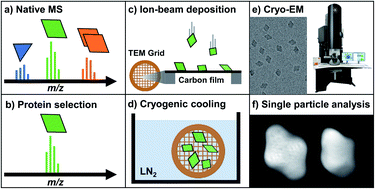
Faraday Discuss., 2022,240, 67-80
https://doi.org/10.1039/D2FD00065B
Bridging length scales from molecules to the whole organism by cryoCLEM and cryoET
Experimental workflows combining mouse genetics, cryogenic correlated light and electron microscopy and cryo-electron tomography to bridge length scales from the whole organism to molecules.
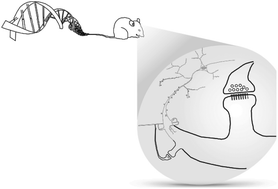
Faraday Discuss., 2022,240, 114-126
https://doi.org/10.1039/D2FD00081D
Escaping the symmetry trap in helical reconstruction
In this study, we reflect on widely-used helical processing routines in cryoEM and suggest a new workflow capable of uncovering heterogeneities and complex symmetries that could otherwise be overlooked.

Faraday Discuss., 2022,240, 303-311
https://doi.org/10.1039/D2FD00051B
cryoWriter: a blotting free cryo-EM preparation system with a climate jet and cover-slip injector
A microfluidic sample preparation method for TEM, which entirely avoids paper blotting and allows the passivation of the air–water interface during the preparation process, is presented.

Faraday Discuss., 2022,240, 55-66
https://doi.org/10.1039/D2FD00066K
Towards sub-millisecond cryo-EM grid preparation
First results from a new cryo-EM grid preparation method are presented, significantly faster than previous methods. The short time delay has the potential to improve grid preparation for challenging samples and to allow faster time-resolved EM.
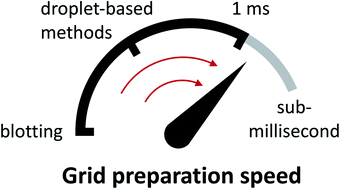
Faraday Discuss., 2022,240, 33-43
https://doi.org/10.1039/D2FD00079B
Overview and applications of map and model validation tools in the CCP-EM software suite
Atomic models from cryo-EM show a preference for geometric quality with the expense of agreement with the map data. This study highlights the lack of validation standards and CCP-EM efforts and related developments in this context.
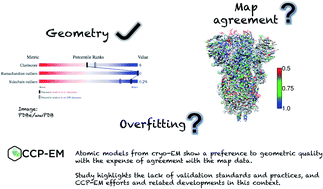
Faraday Discuss., 2022,240, 196-209
https://doi.org/10.1039/D2FD00103A
Customising the plunge-freezing workflow for challenging conditions
Modifications to a commercial plunge-freezer are described, enabling temperature-sensitive, light-sensitive and oxygen-sensitive samples to be frozen for analysis by cryo-TEM.
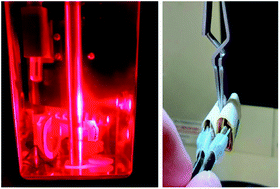
Faraday Discuss., 2022,240, 44-54
https://doi.org/10.1039/D2FD00060A
Cryomicroscopy in situ: what is the smallest molecule that can be directly identified without labels in a cell?
Current and future technology for in situ electron cryomicroscopy is considered from theoretical and practical viewpoints.
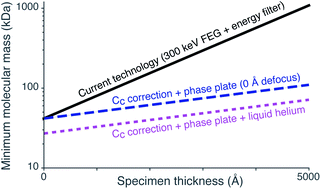
Faraday Discuss., 2022,240, 277-302
https://doi.org/10.1039/D2FD00076H
Maintaining the momentum in cryoEM for biological discovery
Cryo-electron microscopy (cryoEM) has been transformed over the last decade, with continual new hardware and software tools coming online, pushing the boundaries of what is possible and the nature and complexity of projects that can be undertaken.
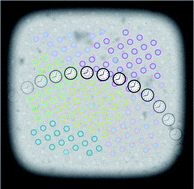
Faraday Discuss., 2022,240, 18-32
https://doi.org/10.1039/D2FD00129B
Diffraction contrast in cryo-scanning transmission electron tomography reveals the boundary of hemozoin crystals in situ
Cryo-STEM tomography (CSTET) reveals the boundary of hemozoin crystals in situ within the digestive vacuole of P. falciparum.
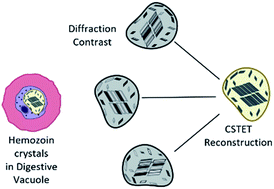
Faraday Discuss., 2022,240, 127-141
https://doi.org/10.1039/D2FD00088A
The impact of AlphaFold2 on experimental structure solution
AlphaFold2 predicts protein folds from sequence, which can be used for experimental structural biology, in construction and de novo protein design, prediction of complexes and perhaps even effects of mutations and conformational space exploration.
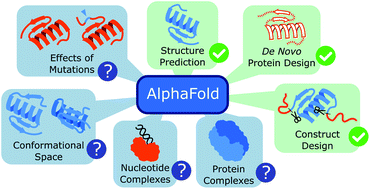
Faraday Discuss., 2022,240, 184-195
https://doi.org/10.1039/D2FD00072E
Electron scattering properties of biological macromolecules and their use for cryo-EM map sharpening
We explore the use of generalised scattering properties of biomolecules for restoration of contrast and visual improvement of cryo-EM maps.
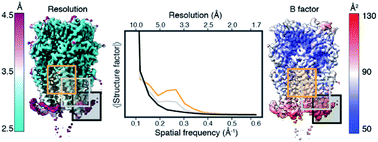
Faraday Discuss., 2022,240, 168-183
https://doi.org/10.1039/D2FD00078D
Application of super-resolution and correlative double sampling in cryo-electron microscopy
A comparison of STA and SPA processed data acquired with/without super-resolution imaging mode enabled.
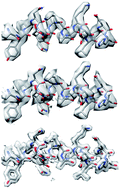
Faraday Discuss., 2022,240, 261-276
https://doi.org/10.1039/D2FD00049K
Reconstruction and validation of entire virus model with complete genome from mixed resolution cryo-EM density
We, for the first time, reconstruct from the published incomplete cryo-EM density a complete MS2 virus at atomistic resolution, that is, the capsid with the genome, and validate the result by all-atom molecular dynamics with explicit water.
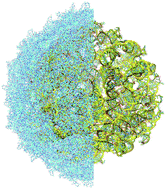
Faraday Discuss., 2022,240, 152-167
https://doi.org/10.1039/D2FD00053A
Strategies for picking membrane-associated particles within subtomogram averaging workflows
In cryo-tomography and subtomogram averaging, particle picking constitutes a major bottleneck and requires significant user time and expertise. Here we summarise particle-picking strategies, focusing in particular on membrane-associated particles.
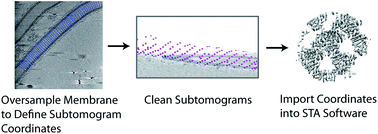
Faraday Discuss., 2022,240, 101-113
https://doi.org/10.1039/D2FD00022A
Image processing tools for the validation of CryoEM maps
A progressive CryoEM map validation scheme is presented. The scheme may include the map, half maps, 2D classes, particles, angles, coordinates, defoci, micrographs, and image processing workflow.
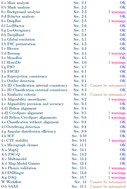
Faraday Discuss., 2022,240, 210-227
https://doi.org/10.1039/D2FD00059H
High-throughput cryo-EM structure determination of amyloids
This paper presents new cryo-EM image processing methods for amyloids, including automated picking and strategies for helical structure determination in RELION. The image shows examples of tau filament structures that were solved using these methods.

Faraday Discuss., 2022,240, 243-260
https://doi.org/10.1039/D2FD00034B
Pushing the limits in single particle cryo-EM: general discussion
Faraday Discuss., 2022,240, 312-322
https://doi.org/10.1039/D2FD90063G
Tomographic analysis, CLEM: general discussion
Faraday Discuss., 2022,240, 142-151
https://doi.org/10.1039/D2FD90060B
Sample preparation in single particle cryo-EM: general discussion
Faraday Discuss., 2022,240, 81-100
https://doi.org/10.1039/D2FD90059A
Map/model validation and machine learning in EM: general discussion
Faraday Discuss., 2022,240, 229-242
https://doi.org/10.1039/D2FD90061K
About this collection
We are delighted to share with you a selection of the papers associated with a Faraday Discussion on Challenges in biological cryo electron microscopy. More information about the related event may be found here: http://rsc.li/microscopy-fd2022. Additional articles will be added to the collection as they are published. The final versions of all the articles presented and a record of the discussions will be published after the event.
Cryo-electron microscopy has undergone significant developments in microscope design, camera technology and data processing regimes, but there are significant challenges that remain and opportunities to explore, many of which must be tackled by the community as a whole rather than by individual groups. This meeting will bring together expertise from both these centres and the international cryo-EM community to discuss the current developments and challenges. This meeting will cover 4 main themes: Sample preparation in single particle cryo-EM, Pushing the limits in single particle cryo-EM, Tomographic analysis, CLEM and Map/model validation and machine learning in EM.
On behalf of the Scientific Committee, we hope you join us and participate in this exciting event, and that you enjoy these articles and the record of the discussion.